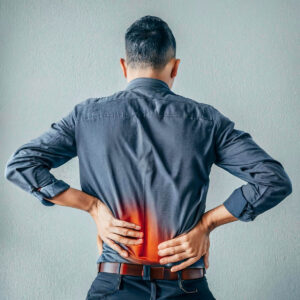Introduction
Temporomandibular Joint (TMJ) disorders are a significant medical condition affecting the jaw joint and muscles. These disorders can cause severe pain and discomfort, impacting daily activities like eating, speaking, and even resting. This condition is prevalent, affecting roughly 10 million in the US. Fortunately, specific TMJ exercises designed for pain relief have shown to be an effective treatment. This blog explores TMJ disorders, detailing symptoms, and causes, and presenting exercises for TMJ as a conservative treatment method, along with other treatment options to manage the condition.
What is TMJ Dysfunction?
The temporomandibular joint connects your jawbone to your skull, functioning as a sliding hinge that allows movement of the jaw. This joint’s complex system, comprising muscles, ligaments, discs, and bones, is essential for all jaw movements. However, temporomandibular disorders can disrupt this system, leading to joint pain, discomfort, and restricted movement, necessitating effective treatment strategies for relief.
Symptoms of TMJ Disorders
TMJ disorders are associated with a variety of symptoms, including:
- Pain or Tenderness: Jaw pain is one of the most common symptoms, indicating problems with the jaw joint or muscles.
- Restricted Jaw Movement: Difficulty in opening or closing the mouth, which could signify joint dysfunction.
- Clicking or Popping Sounds: These sounds may occur with or without pain, indicating a dysfunction in jaw movement.
- Jaw Locking: A condition where the jaw gets stuck in an open or closed position.
- Headaches and Neck Pain: Often resulting from tension in the jaw and neck muscles.
- Ear Pain or Tinnitus: Symptoms can extend to the ear canal, causing discomfort or ringing.
- Dizziness: A feeling of unsteadiness.
- Toothaches: Pain in and around the teeth not caused by dental conditions.
- Facial Pain: Pain extending to areas beyond the jaw.
- Neck and Shoulder Pain: Often associated with TMJ disorders due to muscle tension.
What are the causes of TMJ disorders?
TMJ disorders can result from various factors, including injuries to the jaw, genetic predisposition, history of orthodontics, arthritis, or habits such as bruxism (teeth grinding). Stress is a significant contributor, causing muscle spasms and tension, leading to pain and dysfunction in the jaw joint. In the United States alone, 1 in 12 individuals is suffering from at least one form of TMJ, making it a serious condition that needs attention for treatment.
How TMJ Exercises with Physical Therapy Can Help In Pain Relief?
TMJ treatment exercises aim to alleviate pain through stretching, strengthening, and increasing mobility in the jaw, targeting minimal dysfunction and easing jaw tension. These exercises for TMJ, combined with physical therapy techniques like massage therapy, joint mobilizations, and sometimes anti-inflammation treatments or steroid injections, focus on the articular bone surfaces including the temporal bone, offering a conservative management approach to reduce symptoms and improve joint function.
This type of treatment has advantages over medication, providing a decrease in pain, usually after a month of treatment, and proving to be a cost-effective treatment method. With regular practice, this long-term treatment strategy leads to significant improvement in pain, muscle strength, and joint mobility, enhancing the health outlook of patients.
Best 9 Exercises for TMJ Disorder
Most of the current study underscores the importance of treatment standardization in the management of TMJ disorders, highlighting the efficacy of active mobilization exercises as a cornerstone of physiotherapy intervention. These exercises, are designed to offer patients a viable alternative to invasive interventions and surgical treatments.
With an emphasis on minimal side effects, this approach prioritizes the alleviation of muscle and joint pain and aims to have profound effects on pain and “noise” reduction for the jaw. As the demand for non-invasive treatment options grows, these exercises introduce a series of pain relief methods tailored to enhance the treatment of patients, offering a strategic blend of effectiveness and safety in combating TMJ-related discomfort.
Relaxed Jaw Exercise
A simple exercise that involves gentle pressure to encourage a neutral, relaxed position of the jaw. This helps alleviate muscle tension and pain at rest.

Goldfish Exercises (Partial Opening)
Place your tongue on the roof of your mouth and one finger in front of your ear where your TMJ is located. Place your pointer and middle fingers on the front of your chin. Apply a very gentle pressure backwards. Drop your lower jaw halfway and back. Perform six times in one set. Do this six times daily.
Goldfish Exercises (Full Opening)
Similar to the partial opening, but drop your lower jaw completely. This helps in increasing the jaw’s range of motion.
Chin Tucks
This exercise targets the neck muscles, promoting good posture and reducing neck pain, a common symptom of TMJ disorders.
Resisted Mouth Opening
Place your thumb under your chin. Open your mouth slowly, pushing gently against your chin for resistance. Hold for three to six seconds, and then close your mouth slowly.
Resisted Mouth Closing
Squeeze your chin with your index and thumb finger. Close your mouth as you gently apply pressure, creating resistance.
Tongue Up
With your tongue placed against the roof of the mouth, slowly open and close your mouth.
Side-To-Side Jaw Movements
Place an object about ¼ inch thick between your front teeth. Slowly move your jaw from side to side. As the exercise becomes easier, increase the thickness of the object.
Forward Jaw Movement
Place an object between your front teeth. Move your bottom jaw forward so your bottom teeth are in front of your top teeth. Increase the object’s thickness as the exercise becomes easier.
Other Treatments
For comprehensive TMJ disorder management, incorporating additional treatments is beneficial:
- Avoiding clenching teeth and practicing stress-relief techniques.
- Eating a soft diet to minimize jaw stress.
- Avoiding chewing gum, biting nails, and biting the lower lip to reduce jaw strain.
- Practicing good posture to alleviate neck and shoulder tension.
- Limiting large jaw movements like yawning and shouting.
Discover Relief with Austin Manual Therapy Associates’ Best TMJ Exercises
At Austin Manual Therapy Associates, one of our focus is providing effective treatment and long-term relief from TMJ disorders. With a combination of targeted TMJ pain relief exercises, physical therapy, conservative management, and personalized care, patients can achieve significant improvements in their TMJ dysfunction symptoms.
Contact us today for your TMJ exercises and other physical therapy in Austin needs.
Conclusion
TMJ disorders, with their wide range of painful conditions, require a multifaceted approach for effective treatment. Exercises for TMJ, combined with other conservative treatment options, have proven to be a cost-effective and beneficial method for managing symptoms and improving quality of life. Always consult a healthcare professional, like maxillofacial surgeons or specialists at an orofacial pain center, to ensure a tailored treatment plan that addresses your specific needs.
FAQs
How do you release TMJ tension?
Releasing TMJ tension involves a combination of TMJ exercises, relaxation techniques, and conservative treatments like heat packs, which can significantly decrease baseline pain intensity and improve joint function.
What makes TMJ worse?
Factors like stress, poor posture, and habits such as teeth clenching can exacerbate TMJ symptoms by increasing muscle tension and joint pain.
Is TMJ due to stress?
Yes, stress can play a significant role in the development of TMJ disorders by causing habits that lead to increased joint stress, muscle spasms, and severe pain, underscoring the need for stress management in treatment.






